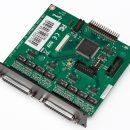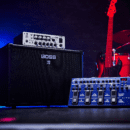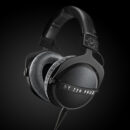It is not vanity, but necessity, that drives us singers in the battle to hear ourselves. Of course it‘s always easier and more enjoyable for any musician to perform when she is able to easily hear herself. But a guitarist can put his fingers on the frets and play the right notes and chords even if he can’t hear, while it is nearly impossible for a singer to hit the right notes without hearing her own voice. No matter how well trained, if you can’t accurately hear your voice and the music during a performance, vocal difficulties and mistakes are probable. In fact, you may unwittingly manipulate the muscles in your throat in an attempt to compensate for what you think you hear. The results are usually not good. The following tips will contribute to your ease of singing and the power of your performance.
1. Monitor Placement and Angle: Where you stand in relation to your monitors makes a big difference in what you hear on stage. For the best sound, you should stay relatively close to your monitors. Position them facing upwards toward each ear at a 45-degree angle. If you can see down the opening of the horns in your monitor, you have them positioned optimally.
2. Avoid Competitive Monitoring: The louder the instrumental stage volume, the more difficult it is for your engineer to achieve a balance of voice to instrument. Straining to hear and be heard is a prime cause of vocal blowout. Discuss with your bandmates the need to keep their stage volume at a moderate level. Putting the drummer behind a Plexiglas cage and having as many band members as possible using headphones or in-ear monitors will reduce the overall stage volume. Reduced stage volume makes it easier for the engineer to provide a good monitor and FOH (front of house) mix.
3. Signal Effects and Pre-Amp Pedal: Most instrumentalists have their own volume knobs and can adjust their stage volume. But you, the singer, are dependent on a sound engineer who can’t hear the stage mix and may be facing certain limitations because of stage volume and feedback. A vocal effects pedal with a pre-amp allows you to control reverb, digital delay and your volume before they go to the mix board. They only work with wired mics, so this would not be an option with wireless mics. Check out pedals by TC-Helicon, Boss and Line 6.
4. Use In-Ear Monitors (IEMs): If affordable, consider being fitted for custom IEMs. An attractive alternative to wedge monitors, IEMs offer a high-quality signal to your ear that allows you to clearly hear the mix at any chosen volume. They provide you with better sound, improved stereo balance, protection against hearing damage from loud stage sound and more. Some of the reputable companies to choose from include Westone, Sensaphonics and Ultimate Ears.
5. A Personal Vocal Monitor: Like microphones, different monitors reproduce sound differently. I’ve found one monitor, brand new to the market, that gives fantastic vocal sound. TC-Helicon and Tannoy partnered to create the VoiceSolo FX150 Personal PA Processor/Monitor. I tried it out at NAMM 2014 and it blew my mind. Not only does it recreate the sound of the voice in a surprisingly inspirational manner; it’s an all-in-one, kick-ass vocal monitor with some of the same features as the Pre-Amp Effects Pedal (Tip 3) and more.
6. Use the Right Mic: The microphone is the single piece of equipment that most influences your singing. Each mic has its own vocal sound; each works with sound differently and has to be matched-up with your voice. If you have sung through many different mics, you probably have noticed variation in the quality of your voice even though you seem to be singing the same way. I always urge singers to have their own mic, one that is matched to their voice and the requirements of their performances.
7. Improve Your Mic Technique: To get the best performance from your mic it needs to be held at the correct distance and optimum angle to your mouth. While it is true that you should pull the mic away from your mouth as you sing louder, it is easy to pull it too far. This can result in a drastic loss of volume and can accentuate the treble frequency band which can effect feedback. Generally, keeping a microphone between one-half to one inch away from your mouth will help to capture the full tone of your voice. If you sing at one-half an inch from the mic and then increase to four inches, you lose 18 dB (decibels - units of sound volume). To the audience your voice will sound almost four times quieter.
8. Hold Your Mic Correctly to Put a Lid on Feedback: The currently popular method of placing a hand around the ball/screen of the mic may look cool, but it can increase the possibility of feedback (requiring the sound engineer to lower your volume). It also tends to muffle the sound of your voice. There is a hand line on every mic shaft. It lies just below the beginning of the ball of the mic and demarcates the highest position of your hand.
9. Good Vocal Technique: When a singer has a voice that doesn’t project, it is a challenge for the sound engineer: There will be a limit to how high the vocal volume can be raised, as feedback will surely occur. If this is the case, research and use a vocal technique with exercises that will strengthen your vocal muscles and provide more tone for less effort. Coupled with the right mic and good mic technique, you’ll give your soundman a much easier time providing you with a better mix.
10. Communicate with Your Sound Engineer: Treat your engineer with respect and make him your ally. Before your gig begins give him your set list with any particular mix needs you have for each song. Then when he can give you his attention, go over it with him and agree on hand signals to use if you need any monitor-mix changes, such as more or less voice.
JEANNIE DEVA is a celebrity voice/performance coach, recording studio vocal specialist and member of the Recording Academy (Grammys). Endorsed by engineers and producers for Aerosmith, Elton John and the Rolling Stones, she is the author of The Contemporary Vocalist book and CD series, The Deva Method Vocal Warm-Up CD and the eBook Singer’s Guide to Powerful Performances, available for all digital tablets. She teaches in Los Angeles (see http://JeannieDeva.com) and internationally via her online video exchange school at http://DevaVocals.com.










